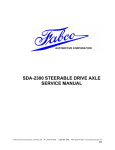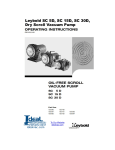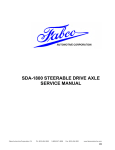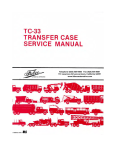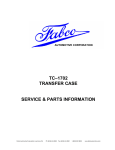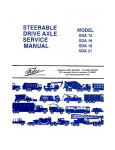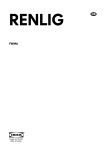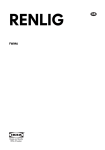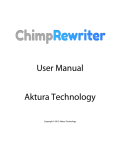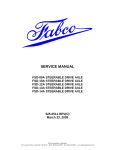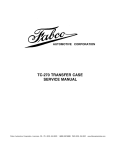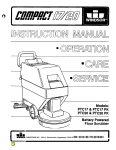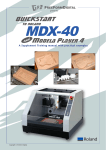Download SDA-1200, SDA-1400 & SDA
Transcript
SERVICE MANUAL SDA-1200 STEERABLE DRIVE AXLE SDA-1400 STEERABLE DRIVE AXLE SDA-1600 STEERABLE DRIVE AXLE WITH EXTENDED SERVICE BRAKES AND ABS PROVISIONS Fabco Automotive Corporation, Livermore, CA VP 9/03 Ph: (925) 454-9500 1- (800) 967- 8838 Fax (925) 454-9501 www.fabcoautomotive.com TABLE OF CONTENTS PAGE 1.0 2.0 3.0 INTRODUCTION ............................................................................................................................... 1 1.1 1.2 1.3 1.4 1.5 1.6 1 1 1 2 2A 2B LUBRICATION .................................................................................................................................. 3 2.1 2.2 2.3 2.4 2.5 2.6 Wheel Bearings····················································································································· Universal Joints····················································································································· Kingpin Bearings··················································································································· Differential Carrier················································································································· Steering Tie Rod Ends·········································································································· Spindle Inner Bearings·········································································································· 3 3 3 3 3 3 AXLE ADJUSTMENT........................................................................................................................ 4 3.1 3.2 3.3 3.4 3.5 3.6 3.7 3.8 3.9 4.0 General ································································································································· Wheel Bearing Adjustment ··································································································· Kingpin Adjustment ··············································································································· Toe-in Adjustment················································································································· Steering Stop Adjustment ····································································································· Camber Adjustment ·············································································································· Caster Adjustment ················································································································ Brake Adjustment·················································································································· Universal Joint Adjustment ··································································································· 4 4 4-5 5 6 6 6 6 6-7 STEERABLE DRIVE END DISASSEMBLY...................................................................................... 7 4.1 4.2 4.3 4.4 5.0 6.0 General Description ·············································································································· Operation ······························································································································ Operating Instructions··········································································································· SDA-1200 Specifications ······································································································ SDA-1400 Specifications ······································································································ SDA-1600 Specifications ······································································································ General Precautions for Disassembly··················································································· Brake Drum, Hub, and Wheel Bearings················································································ Brake and Wheel Spindle ····································································································· Splindle Yoke Removal········································································································· 7 7-8 8-9 9-10 CLEANING AND INSPECTION ........................................................................................................ 10 5.1 5.2 5.3 Choice of Cleaning Methods································································································· Drying and Corrosion Inhibition····························································································· Inspection······························································································································ 10 10 10 STEERABLE DRIVE END ASSEMBLY............................................................................................ 10 General Precautions for Assembly ······················································································· Spindle Installation················································································································ Brake Equipment ·················································································································· Wheel Bearings, Hub, and Brake Drum················································································ 10 11-12 12-13 13 6.1 6.2 6.3 6.4 TABLE OF CONTENTS PAGE 7.0 ADDITIONAL SERVICE PROCEDURES.......................................................................................... 14 7.1 7.2 Steerable Drive End Removal······························································································· Differential Carrier Removal·································································································· 14 15 8.0 TORQUE SPECIFICATIONS ............................................................................................................ 16 9.0 SPECIAL TOOLS .............................................................................................................................. 17 9.1 9.2 9.3 9.4 9.5 9.6 9.7 9.8A 9.8A 9.8B 9.9 17 18 19 20 21 22 23 24 24 25 26 10.0 ABS PARTS & SERVICE.................................................................................................................. ABS-1 10.1 10.2 10.3 10.4 11.0 Spindle Seal Driver ··············································································································· Hub Seal Driver····················································································································· Lower Kingpin Seal Driver ···································································································· Upper Kingpin Seal Driver ···································································································· Axle Seal Driver ···················································································································· Lower Kingpin Locknut Wrench ···························································································· Upper Kingpin Ball Stud Puller······························································································ Differential Carrier Removal Tool – SDA-1200 & 1400························································· Differential Carrier Removal Tool – SDA-1600 ····································································· Steerable End Adapter·········································································································· Inner Spindle Greasing Tool ································································································· ABS Sensor Removal ··········································································································· ABS Sensor Inspection ········································································································· ABS Sensor Installation ········································································································ ABS Sensor Operational Test······························································································· Figure 10.1: ABS Assembly, Left-hand Side········································································ Figure 10.2: Clamp Assembly, ABS Cable Inside Steerable End········································ Figure 10.3: Bracket Assembly, ABS Cable, Left-hand Side ··············································· ABS-1 ABS-1 ABS-1 ABS-1 ABS-2 ABS-3 ABS-3 ILLUSTRATED PARTS..................................................................................................................... IP-1 11.1 11.2 SDA-1200, 1400 & 1600 IIlustrated Parts············································································· SDA-1200, 1400 & 1600 Illustrated Parts List ······································································ Copyright © 1999 IP-1 IP-2-6 Fabco Automotive Corporation, 151 Lawrence Drive, Livermore, CA 94551 ASBESTOS WARNING SUGGESTED PROCEDURES FOR WORKING WITH COMPONENTS SUSPECTED OF CONTAINING ASBESTOS Asbestos has been found to be a primary cause of various forms of respiratory disease and cancer of several vital body organs. Primary ingestion is by breathing or swallowing airborne dust containing fibers. Smokers are at a greater risk than those who do not smoke. The onset of such a fatal disease can be at an extended period of time, (several years) after the exposure. The Occupational and Safety Health Administration (OSHA) has established very stringent limitations for exposure to asbestos fibers by workers using the material, and every precaution should be taken to minimize the risks involved. The following are some suggested procedures to adopt when working with material that has, or may be suspected of containing, asbestos. 1. Approved protective clothing, gloves, eye shield and aprons should be worn whenever working around the suspected material. NIOSH & OSHA approved respirator masks suitable for asbestos dust should be worn at all times. Disposable dust face masks are not allowed by OSHA. 2. Do not smoke while working on any asbestos related material or wearing protective apparel. 3. Do not eat or drink food while wearing protective clothing. Always wash before eating, drinking or smoking. 4. Do not use compressed air for any dirt removal. Use only approved high efficiency vacuum cleaners suitable for use with asbestos. Do not dry brush deposits or accumulations of dirt from components. What cannot be removed with the high efficiency vacuum cleaner should be washed with a water soaked rag. The rag should not be wrung dry but should be disposed of, together with other wastes containing asbestos in specially sealed and marked containers in accordance with EPA and OSHA regulations. 5. Do not wear protective clothing away from the working area, vacuum clean clothing before removal. Shower, if possible, before going home. These suggestions are neither complete nor authoritative on the subject of working with asbestos but are meant as a warning of the possible risks. It is the responsibility of the supervising authority to be aware of the possible dangers involved and to provide suitable training, precaution and protection for those working in an asbestos environment. 1.0 INTRODUCTION 1.1 GENERAL DESCRIPTION The Fabco Steerable Drive Axle consists of four major assemblies; the axle housing, two steerable drive ends, and a differential carrier. A steering tie rod links the right and left steerable ends, and steering input is delivered via a steering arm. The arm is usually located on the left steerable end, although right hand or even dual steering arms are available. When steered, the outer section of each steerable drive end rotates about the kingpin centerline. The U-joint, centered on the kingpin centerline, allows power to be transmitted throughout the possible range of steering inputs. The axle is equipped with S--cam air brakes and automatic slack adjusters. 1.2 OPERATION 1.3 OPERATING INSTRUCTIONS Driving forces are put into the axle at the pinion yoke on the differential carrier; they pass through the differential to the inner axle shafts and on to the universal joints. The yoke shafts get their power from the U-joints and transfer it by means of splines to the drive flanges, which are bolted to the wheel hubs, thus rotating the wheels. In conditions where the vehicle's rear wheels might spin, such as sand, loose dirt, mud, snow, ice, or ascending grades, the front drive axle can be shifted into operation for improved traction. Engagement can be made at any vehicle speed, provided that the rear wheels are not spinning. Engagement is best accomplished when the engine is pulling lightly. – 1– 1.4 STEERABLE DRIVE AXLE SPECIFICATIONS — FABCO MODEL SDA-1200 MAXIMUM CAPACITY 12,000 Pounds Load Rating BRAKES Type Size Chamber Certification Slack Adjusters Drum, S-Cam 16.5 Diameter x 5 Inch 20 Square Inch FMVSS 121 Automatic HOUSING Fabricated Steel, Cast Banjo CAMBER 1/2° Positive WHEELS Mounting Minimum Wheel Size DIFFERENTIAL CARRIER Ring Gear Diameter Pinion Spline Single Reduction Ratios UNIVERSAL JOINT 10-Studs on 11.25 Inch Bolt Circle 20 Inch Hypoid 13.4 Inch 1.75 Diameter, 34 Spline Involute 3.55, 3.70, 3.90, 4.11, 4.33, 4.63, 4.88, 5.29, 5.38, 5.57, 5.83, 6.17, 6.50, 7.17 Single Cardan KINGPINS Type Inclination Spherical 5° STEERING Ackerman to Match Wheelbases 146" to 183" or 184" to 222" TRACK 91.1 Inches over Wheel Mounting Faces AXLE SHAFTS Spline Body TURN ANGLE 1.75 Inch Diameter, 34 Spline Involute 1.69 Inch Diameter 35° LUBRICATION Type Capacity WEIGHT – Dry SAE 90, 140, 80W-140, Synthetic Acceptable Approximately 9.5 Quarts 1,435 Lbs. –2– 1.5 STEERABLE DRIVE AXLE SPECIFICATIONS — FABCO MODEL SDA-1400 MAXIMUM CAPACITY 14,000 Pounds Load Rating BRAKES Type Size Chamber Certification Slack Adjusters Drum, S-Cam 16.5 Diameter x 5 Inch 20 Square Inch FMVSS 121 Automatic HOUSING Fabricated Steel, Cast Banjo CAMBER 1/2° Positive WHEELS Mounting Minimum Wheel Size DIFFERENTIAL CARRIER Ring Gear Diameter Pinion Spline Single Reduction Ratios UNIVERSAL JOINT 10-Studs on 11.25 Inch Bolt Circle 20 Inch Hypoid 13.4 Inch 1.75 Diameter, 34 Spline Involute 3.55, 3.70, 3.90, 4.11, 4.33, 4.63, 4.88, 5.29, 5.38, 5.57, 5,83, 6.17, 6.50, 7.17 Single Cardan KINGPINS Type Inclination Spherical 5° STEERING Ackerman to Match Wheelbases 146" to 183" or 184" to 222" Dual Steering Arms TRACK 91.1 Inches over Wheel Mounting Faces AXLE SHAFTS Spline Body TURN ANGLE 1.75 Inch Diameter, 34 Spline Involute 1.69 Inch Diameter 35° LUBRICATION Type Capacity WEIGHT – Dry SAE 90, 140, 80W-140, Synthetic Acceptable Approximately 9.5 Quarts 1,455 Lbs. – 2A – 1.6 STEERABLE DRIVE AXLE SPECIFICATIONS — FABCO MODEL SDA-1600 MAXIMUM CAPACITY 16,000 Pounds Load Rating BRAKES Type Size Chamber Certification Slack Adjusters Drum, S-Cam 16.5 Diameter x 6 Inch 24 Square Inch FMVSS 121 Automatic HOUSING Fabricated Steel, Cast Banjo CAMBER 1/2° Positive WHEELS Mounting Minimum Wheel Size DIFFERENTIAL CARRIER Ring Gear Diameter Pinion Spline Single Reduction Ratios UNIVERSAL JOINT 10-Studs on 11.25 Inch Bolt Circle 20 Inch Hypoid 14.5 Inch 1.75 Diameter, 34 Spline Involute 3.55, 3.70, 3.90, 4.11, 4.33, 4.63, 4.88, 5.29, 5.38, 5.57, 5.83, 6.17, 6.50, 7.17 Single Cardan KINGPINS Type Inclination Spherical 5° STEERING Ackerman to Match Wheelbases 146" to 183" or 184" to 226" Dual Steering Arms TRACK 91.1 Inches over Wheel Mounting Faces AXLE SHAFTS Spline Body TURN ANGLE 1.85 Inch Diameter, 36 Spline Involute 1.69 Inch Diameter 35° LUBRICATION Type Capacity WEIGHT – Dry SAE 90, 140, 80W-140, Synthetic Acceptable Approximately 9.5 Quarts 1,550 Lbs. – 2B – 2.0 LUBRICATION 2.4 DIFFERENTIAL CARRIERS Recommended Lubricants Differential carriers should have the lubricant changed at the same interval as the rear axle on the vehicle, or approximately 10,000 miles. Drain while lubricant is warm and clean the magnetic drain plug. Removal of the fill plug will allow quicker drainage. Be sure to allow the housing to drain completely. Reinstall the drain plug and fill the housing to the bottom of the fill plug with the appropriate gear oil. Check for leaks. SAE 140 gear oil (meeting MIL-L-2105 B) is appropriate for most operating conditions. For extreme conditions, follow the vehicle manufacturers recommendations for the rear axle and apply them to the front axle. 1. Gear Oil: Temperature Grade Above 32° F (0° C) MIL-L-2105 SAE 140 MIL-L-2105 80W-140 Below 32° F (0° C) MIL-L-2105 SAE 90 MIL-L-2105 80W-90 2.5 STEERING TIE ROD ENDS 2. Chassis Grease: Temperature Grade Above 32° F (0° C) MIL-G-10294 Below 32° F (0° C) MIL-G-10294 Tie rod ends should be lubricated every 1,000 miles at each chassis lubrication. See Figure 1. Inspect for loose, bent, or otherwise damaged components. Careful attention to such detail is a vital safety factor. 2.6 SPINDLE INNER BEARINGS 3. Wheel Bearing Grease: Temperature Grade Above 32° F (0° C) NLGI Grade #2 Below 32° F (0° C) NLGI Grade #2 The spindle inner bearings require inspection, cleaning, and packing with grease every 16,000 miles or 1 year. Remove the brake drum, drive flange, hub, brakes, and spindle. Grease the spindle inner bearing surface and pack the cavity between the bearing and seal with grease. Special greasing tool, Fabco part number 866-0749 may be used. See figure 1 for lubrication points. Not shown is the air chamber mounting bracket grease fitting, located on the bottom of the bracket tube inside the spindle yoke. 2.1 WHEEL BEARINGS Wheel bearings require cleaning, inspection, and packing with grease at each brake reline. Wheel bearings should be lubricated in accordance with the vehicle manufacturer's recommendations. When greasing, liberally pack both inner and outer bearings, ensuring that the grease has penetrated thoroughly into the cage and roller assembly. Prior to reassembly, coat the raceways and interior hub surfaces as well. 2.2 UNIVERSAL JOINTS Universal joints are lubricated and sealed at the factory, and should require no additional maintenance throughout their service life. 2.3 KINGPIN BEARINGS Kingpin bearings should be lubricated at each chassis lubrication (approximately 1,000 mile intervals). See Figure 1. To ensure thorough lubrication, the front axle should be raised to relieve weight. The lower kingpin lube fitting is located in the bottom of the lower kingpin ball stud itself. The upper kingpin fitting is on the steering arm or upper kingpin cap. Figure 1 –3– 5. Torque the bearing adjusting nut to 50 lbs. ft. while simultaneously rotating the hub assembly. Loosen the nut and repeat this procedure 2-3 times to ensure that the bearings are seated properly. After the final tightening, back off the nut 1/4 turn. See Figure 3. 3.0 AXLE ADJUSTMENT 3.1 GENERAL Adjustments may be necessary after an accident, in response to or to correct steering problems, tire wear problems, or as part of the reassembly process after a thorough inspection. 3.2 WHEEL BEARING ADJUSTMENT 1. The front of the vehicle should be raised, properly supported, and the front wheels removed from the axle. 2. Remove the eight 1/2" outer drive flange locknuts, and the 1 1/4" flanged axle locknut. See Figure 2. Figure 3 6. Install the wheel bearing lock washer, and back off the adjusting nut just enough to allow its dowel pin to engage in the lock washer's closest hole. Install and torque the locknut to 400 lbs. ft. 7. Optimally, the wheel bearing end play should be checked with a dial indicator as part of the adjustment procedure. The correct setting is .002"-.004". 8. Reinstall the drive flange over the hub assembly. Torque the drive flange locknuts to 100 lbs. ft., and the flanged axle locknut to 400 lbs. ft. Figure 2 3. The drive flange should be loose enough to remove by hand. If it is not, use two 3/8"-16 bolts in the extractor holes provided for this purpose. Do not disturb the colored drive flange shims. 3.3 KINGPIN ADJUSTMENT 1. The front of the vehicle should be raised, properly supported, and the front wheels removed from the axle. 4. Remove the wheel bearing locknut and washer from the spindle and loosen the bearing adjusting nut. 2. Loosen the lower kingpin jam nut and back it down enough to allow the lower kingpin lock washer to disengage from its retaining dowel pin. Back the lower kingpin ball stud down four complete turns. – 4– 3. Loosen the upper kingpin adjustment jam nut and back out the adjusting screw four full turns. The drive end assembly will begin to lower as the screw is turned out. See Figure 4. 6. Advance the lower kingpin ball stud until the stack of feeler gage blades begins to loosen, indicating that the ball stud threads are actually beginning to spread the suspension and spindle yokes apart. Back off the ball stud just enough to allow the closest hole in the kingpin lock washer to engage the retaining dowel pin. Torque the locknut to 600 lbs. ft. 7. Back out the upper kingpin adjusting screw just enough to relieve pressure so the end can turn freely (approximately 1/16 turn) and torque the jam nut to 45 lbs. ft. 3.4 TOE-IN ADJUSTMENT It is not recommended to raise the front of the truck to check toe-in; at the factory, the setting is made with the axle loaded to simulate actual operating conditions. An expandable toe-in alignment bar is recommended. Since the SDA-1200, 1400, and 1600 axles use an offset tie rod tube, adjustment is not made by turning the tube itself, but rather by rotating a small adjuster located at the left end of the tube. See Figure 6. It is critical to making the adjustment accurately that the front wheels are as close to straight ahead as possible. Figure 4 4. Begin tightening the adjusting screw and continue until upward motion of the drive end stops. If a finger is placed near the gap between the suspension and spindle yokes, the point at which upward travel stops can be readily felt. Additional resistance will also be felt in the effort required to turn the adjusting screw. The upper kingpin has now been seated in its bushing. 5. Place a stack of feeler gages in the gap between the suspension and spindle yokes in the area of the lower kingpin ball stud. The gages should fit snugly. See Figure 5. Figure 6 1. Loosen the tie rod adjuster clamp and left tie rod clamp. Toe-in is increased by unscrewing the adjuster from the tie rod itself. The correct setting is 1/16" ± 1/16" toe-in. In the case of a vehicle with full-time four-wheel drive (proportioning differential), the setting reverts to 1/16" ± 1/16" toe-out (greater distance in the front than the rear). Consult a tire specialist for a specific recommendation if specialized tires are used. 2. Tighten both clamp bolts to 75 lbs. ft. Roll the vehicle forward a distance equal to four rotations of the wheels, taking care to maintain their straight-ahead alignment. Recheck the toe-in and repeat this procedure if necessary to obtain the correct dimension. Figure 5 – 5– 1. Using a 7/16 socket, rotate the hex extension on the front of the slack adjuster clockwise until the shoes first contact the drum. See Figure 7. Rotate the hex extension 1/2 turn counterclockwise to back off the shoes and provide initial running clearance. A ratcheting noise while backing off is normal. 3.5 STEERING STOP ADJUSTMENT The steering stop adjustment is made at the factory. There should be no need to alter it, barring a case where a major component such as the axle housing or a spindle yoke has been replaced for some reason. The turn angle is set at 35°, and this can be checked with a carpenter's power saw protractor on the wheel's inside rim and a T-square laid along the frame rail with the vehicle's steering at full lock. If an adjustment is necessary, loosen the steering stop jam nut on the rear of the spindle yoke and turn the 12-point adjusting screw. Torque the jam nut to 75 lbs. ft. The toe-in adjustment (Section 3.4) should be completed before performing this procedure. NOTE: POWER STEERING STOPS IN THE VEHICLE STEERING GEAR SHOULD NOT ALLOW THE APPLICATION OF POWER TO THE STEERING WHEN THE STEERABLE DRIVE END IS IN THE FULL TURN CONDITION. 3.6 CAMBER ADJUSTMENT Camber is set at the factory and is integral to the manufacture of the housing and steerable end components. It cannot be changed. 3.7 CASTER ADJUSTMENT Caster is specified by the vehicle manufacturer and can be adjusted only by means of shims between the axle spring seat and the spring. Changing the caster will change the pinion angle and may affect the operation of the front drive shaft. Figure 7 2. See that the drum rotates freely. Scraping noises are OK, but no heavy drag should exist. If excessive friction is present, continue to back off the hex extension in 1/8 turn increments until free motion is restored. Remember: It is preferable to have a slightly loose initial setting than one that is too tight, because the adjuster will remove extra slack, but cannot add any. 3.8 BRAKE ADJUSTMENT After an initial set-up procedure, brake adjustment is made automatically by the slack adjusters, and should require no attention between relines. To adjust the slack after a brake reline: 3.9 UNIVERSAL JOINT ADJUSTMENT Universal joint adjustment is made at the factory and is controlled by means of shims placed between the drive flange and the outer surface of the hub. Adjustment should only be required if three or more of the following components have been replaced since the unit was manufactured: Drive flange, outer axle shaft, spindle, spindle yoke, or hub. To check the adjustment: 1. Turn the steerable end in question to full lock. It may be necessary to remove the wheel to gain sufficient access. –6– 2. Place one end of a 6" machinist's rule against the flat inner surface of the spindle which pilots into the spindle yoke. See Figure 8. 3. Prepare a clean place to work. It is important that no dirt or foreign material be allowed to enter the unit during repairs. 4. Refer to the exploded views located in the parts section as an aid in disassembly. 5. When disassembling the various assemblies, lay all parts on a clean bench in the same sequence as removed. This procedure will simplify reassembly and reduce the possibility of losing parts. 6. Carefully wash and relubricate all bearings as removed, and protectively wrap until ready for use. Remove bearings with pullers designed for this purpose, or in a manner which will not damage those bearings that will be reused. 7. When necessary to apply force to remove a part, use of a puller or press is preferred. In some cases, use of a bar or soft hammer may be allowable. 4.2 BRAKE DRUM, HUB, AND WHEEL BEARINGS 1. Raise the front of the vehicle with a jack and secure with jackstands of suitable capacity. Remove front wheels. Figure 8 3. Measure the distance to the bottom of the rectangular locating slot for the universal joint in the yoke shaft. The measurement should be 2.141 ± .030. If necessary, bring the dimension within specification by altering the number of shims between the drive flange and hub. 2. Remove the brake drums, taking suitable precautions if the possibility of exposure to asbestos dust exists. See Asbestos Warning located after axle specifications. Fabco original equipment brake shoes are not asbestos based. 3. Remove the eight 1/2" outer drive flange locknuts, and the 1 1/4" flanged axle locknut. 4.0 STEERABLE DRIVE END DISASSEMBLY 4. The drive flange should be loose enough to remove by hand. If it is not, use two 3/8"--16 bolts in the extractor holes provided for this purpose. Set the colored drive flange shims aside for later reuse. 4.1 GENERAL PRECAUTIONS FOR DISASSEMBLY IMPORTANT: READ THIS SECTION BEFORE STARTING THE DISASSEMBLY PROCEDURES. 5. Remove the wheel bearing locknut, washer, and adjusting nut from the spindle. Rock the hub in place to loosen the outer wheel bearing cone. Remove the cone and wrap it protectively. 1. Follow each procedure closely in each section, making use of both text and figures. 2. The outside of the unit should be carefully cleaned before starting disassembly. If steam cleaning, ensure that breather and air fittings are covered to prevent moisture from entering assembly. –7– 6. Remove the hub, initially attempting to pull the assembly straight off to avoid cocking the inner bearing cone. See Figure 9. If the cone binds against the spindle try rocking the hub to free it, but it may be necessary to use a pry bar under the inner surface of the hub. To avoid damaging the inner seal, pry against the hub only. If the inner bearing remains on the spindle when the hub is removed, use a suitable puller to remove it, pulling only against the bearing's race. Alternately, tap lightly on the race's outboard surface with a small drift to correct its misalignment and again attempt to remove it by hand. Figure 10 3. After detaching the retaining springs, the shoes may be removed from the brake spider plate. Alternately, the spider plate, dust shield and brake shoes may be removed as a unit. 4. Pry the S-camshaft's retaining snap ring out of its groove. Set it and the shims under it aside for reuse. 5. Pull the S-camshaft out of the air chamber mounting bracket and slack adjuster, taking care not to lose the washer located between these two. Figure 9 7. Wheel bearing cups may be driven from the hub using a suitable puller in the slots provided in the hub's inner cavity. Pull the cup out evenly by using both slots. 6. Remove both cotter pins and clevis pins from the slack adjuster to detach it from the air chamber push rod. It may be necessary to turn the adjuster slightly to withdraw the clevis pins from their holes. See Figure 11. NOTE: This is the limit of routine disassembly. Brake shoes and wheel bearings may be accessed for maintenance, but further disassembly may be required to replace damaged or broken parts. 4.3 BRAKE AND WHEEL SPINDLE 1. Removal of the brake shoes will be facilitated by turning out the 7/16" adjustment screw on the slack adjuster to relieve tension on the S-cam rollers. Turn the screw counterclockwise until the rollers rest at the lowest point on the cam. 2. Insert a suitable pry bar down between the top of the brake shoe and a spindle locknut. Pry the shoe away from the S-cam and remove the roller. DO NOT ALLOW YOUR FINGERS TO COME DIRECTLY BETWEEN THE SHOE AND THE S-CAM! Relax the spring tension, then remove the opposite roller in like fashion. See Figure 10. Figure 11 –8– 7. Remove the two 5/8" air chamber mounting nuts and washers to detach the chamber from the mounting bracket. The mounting bracket itself can be withdrawn from the spindle yoke following removal of its two 1/2" mounting nuts. 3. Loosen the upper kingpin adjusting screw jam nut and back out the adjusting screw until the spindle yoke stops moving downward and is resting on the suspension yoke. Remove the four 3/4" steering arm or upper kingpin cap locknuts, and pull the arm or cap up and off its mounting studs. If difficulty is encountered, turn the adjusting screw back in to force the arm or cap off the studs. See Figure 13. 8. Remove the ten 5/8" locknuts which secure the spindle and the dust shield/brake spider assembly. A little persuasion with a soft mallet may be necessary to free up these components. See Figure 12. Figure 13 Figure 12 4. Remove the 7/8" upper kingpin bolt and its locknut and two attendant washers from the suspension yoke. Special tool number 866-0706 (see section 9.7) should now be used to pull the upper kingpin ball stud from the suspension yoke. Do not try to remove the ball stud by rocking the spindle yoke, as this may affect the critical press fit between the ball stud and suspension yoke. Fit the tool's two tubes over two diagonally located steering arm or upper kingpin cap studs. Insert the 1"-14 bolt through the washer and the tool's central hole and start it in the threads in the top of the upper kingpin ball stud. Tighten the bolt until the ball stud is pulled free of the suspension yoke. Remove the tool, grasp the spindle yoke at the top, and rotate it outward and down to disengage it from the suspension yoke. 9. The axle shaft may now be withdrawn from the differential through the spindle yoke to provide access to the inner axle seal. Removal of the seal will be considerably easier if the spindle yoke is first removed as described in the following section. Extract the seal with a suitable puller or slide hammer. Do not attempt to remove the seal unless it is to be replaced with a new part. 4.4 SPINDLE YOKE REMOVAL 1. Due to its high torque, loosening of the lower kingpin locknut is more easily accomplished while the spindle yoke is still mounted. (See Section 9.6 for Fabco special tool number 866 600 003.) If removal of the lower kingpin ball stud is not anticipated, removal of the spindle yoke can be carried out with the ball stud and locknut intact. 2. Remove the cotter pins from both tie rod ends. Unscrew both castle nuts so that only a few threads remain in engagement. Use a suitable puller to extract the tie rod end from the suspension yoke. Do not strike the tie rod end ball stud. Completely remove the nuts and tie rod. –9– 5. Remove the lower kingpin bearing and seal from the suspension yoke by inserting a 7/8" or smaller flat--headed bar through the upper kingpin bolt hole so it contacts the lower kingpin plate. See Figure 14. Strike the top of the bar to drive out the bearing. Do not remove the upper kingpin bearing from the spindle yoke unless it has been determined that replacement will be necessary. The upper bearing may be driven out by the bottom of its inside edge using a chisel or drift or by melting it with a propane torch. This latter approach must be used with caution, however. 5.2 DRYING AND CORROSION INHIBITION Soft clean shop towels should be used to dry parts after cleaning. Compressed air may be used to clean accessible areas of large parts such as the housing. Bearings should not be spun dry with compressed air as the lack of lubrication may cause damage to the mating surfaces. Dry parts should be immediately coated with a light oil or a corrosion inhibitor to prevent corrosion damage. Parts which are to be stored should also be wrapped in heavy waxed paper. 5.3 INSPECTION Prior to reassembly, parts which are to be reused must be carefully inspected for signs of wear or damage. Replacement of such parts can prevent costly downtime at a future date. All bearing and bushing surfaces including roller bearing cups and cones should be examined for pitting, wear, or overheating. Shafts may be nicked and marred or have damaged threads. Inspect all structural members and welds closely for any signs of cracking. Parts which show any sign of damage should be repaired or replaced. 6.0 STEERABLE DRIVE END ASSEMBLY 6.1 GENERAL PRECAUTIONS FOR ASSEMBLY 1. Assembly Figure 14 Refer to the exploded views located in the parts section as an aid to assembly. 5.0 CLEANING AND INSPECTION 2. Initial Lubrication 5.1 CHOICE OF CLEANING METHODS Splines should be coated and sealing lips on grease seals filled with grease prior to reassembly to provide lubrication upon start up. 1. Steam may be used for external cleaning of completely assembled units. Care must be taken to ensure that water is kept out of the assembly by tightly closing breather caps and other openings. 3. Bearings Use of flanged-end bearing drivers is recommended for the installation of bearings and races. These drivers only apply force to the races of the bearing, preventing damage and maintaining alignment with the shaft and bore. 2. Rough parts such as housings, which are too large to conveniently clean with solvents, may be immersed in a hot solution tank containing a mild alkaline solution. Parts cleaned in hot solution tanks must be rinsed thoroughly to prevent damage by traces of alkaline material. 4. Seals Use a flanged type guide or driver to install seals. If a driver is not available, use of a soft hammer and/or wood blocks may be made, provided that care is exercised. Proprietary drivers are available directly from Fabco and drawings are also provided in Section 10.0 3. Parts with ground or polished surfaces, such as bearings or shafts, should be cleaned with emulsion cleaners or petroleum solvents. Alkaline hot solution tanks may damage the machined surfaces and should be avoided. – 10 – 6.2 SPINDLE INSTALLATION 1. If the inner axle seal has been removed, smear grease on the inner bushing surface of the replacement part and apply a thin bead of Loctite #515 or equivalent to the outer surface. Drive it into the suspension yoke until it seats squarely against the shoulder of the bore. See Figure 15. Figure 17 Screw the lower kingpin ball stud into the spin3. dle yoke until the top of the threaded portion is flush with the inside surface of the yoke. Ensure that the locating pin for the kingpin lock washer is in position in the yoke, then loosely install the lock washer and nut. Figure 15 4. Smear the spherical portion of the lower kingpin ball stud with grease. Grasping the spindle yoke with both hands, place the lower ball stud in its bearing and rotate the top of the spindle yoke over the upper suspension yoke. 2. Place the lower kingpin plate in the suspension yoke and drive in the bearing and seal after it. Both upper and lower kingpin seals must be installed in their bores w/grease lips facing outward. If the upper kingpin bearing has been removed, install the new part using either a pusher plate or the old part as a driver. See Figure 16. If necessary, install a new upper kingpin seal against its shoulder opposite the upper kingpin bearing. See Figure 17. 5. Smear grease in the upper kingpin bearing and start the upper ball stud through the bearing and into its bore in the suspension yoke. Place one upper kingpin washer on the upper kingpin bolt and insert the bolt up through the suspension yoke and upper kingpin ball stud. Install the other washer and the 7/8" locknut on the bolt and torque to 500 lbs. ft. 6. After wiping both mounting surfaces clean of grease, push the steering arm or upper kingpin cap down over its mounting studs, install the four 3/4" nuts, and torque to 250 lbs. ft. Install the upper kingpin adjusting screw, its jam nut, and the lubrication fitting in the cap or arm. 7. Complete steps 4 – 7 of Section 3.3 (Kingpin Adjustment) in this manual. Figure 16 – 11 – 8. Insert the tip of the axle shaft carefully through the inner axle seal and continue to push the assembly in until it can be felt to contact the differential. Rotate the assembly so the yoke shaft mounting faces are horizontal. By using a bar placed between the universal joint and the yoke shaft as a lever, the tip of the axle shaft inside the housing can be raised sufficiently to allow it to engage with the differential splines. See Figure 18. 10. Install the dust shield/brake spider assembly onto the spindle yoke studs with the large hole positioned to receive the air chamber mounting bracket. Install the ten 5/8" locknuts and torque to 175 lb.-ft. On axles equipped with ABS, use the short nuts (2 per end) on the studs used to attach the ABS sensor bracket. See Section 10 for details. 11. Reinstall the tie rod end, torque the castle nut to 100 lb.-ft., and fit a new cotter pin. 6.3 BRAKE EQUIPMENT 1. If necessary, press new seals and bushings into the air chamber mounting bracket. Seals must be installed flush so that the lip side (with spring) of both seals face toward the slack adjuster end of the bracket. Improperly oriented seals may allow grease to exit the camshaft head end of the air chamber bracket and contaminate the linings. Recess cam head end bushing 9/32". Recess slack adjuster end bushing 22/32". See Figure 20. Coat the bushings with grease and install the mounting bracket on the spindle yoke. Torque the two 1/2" bracket mounting nuts to 150 lb.-ft. Figure 18 9. If the spindle sleeve bearing has been removed, press the replacement bearing into the spindle. The groove in the bearing should be located ± 90° from the large keyway on the outside surface of the spindle. DO NOT PRESS THE TOP OF THE BEARING IN PAST THE SPINDLE CHAMFER! Install the yoke shaft seal in the spindle. See Figure 19. Grease the bearing's inner surface, and pack the cavity between bearing and seal with grease. Slide the spindle over the yoke shaft and spindle yoke studs. The large keyway must be located at the 12 o'clock position. Figure 20 2. Push the S-camshaft all the way into the mounting bracket from the wheel side until the cam head contacts the bracket. Left and right hand shafts are not interchangeable. Place the inner slack adjuster washer over the splined end of the shaft. 3. If a new air chamber is being installed, thread the air chamber adjustment jam nut on its pushrod. Screw the adjustment nut on after it so that its small end is flush with the pushrod end. Torque the jam nut to 75 lb.-ft. against the adjustment nut to lock in place. Fit the air chamber mounting studs through their holes in the bracket and secure with the two 5/8" locknuts and washers. Torque to 150 lb.-ft. Figure 19 – 12 – 4. Install the slack adjuster over the S-camshaft with the 7/16" adjusting screw pointing toward the front of the axle. Begin by placing two .060" and two .030" spacers over the end of the S-cam shaft. Install the snap ring. 6.4 WHEEL BEARINGS, HUB, AND BRAKE DRUM 1. Press both wheel bearing cups into the hub. Thoroughly pack both bearing cones with grease, and coat the inside surfaces of the hub and bearing cups. Install the inner wheel bearing cone and the hub seal in the hub. See Figure 22. Lightly coat the outer surface of the spindle with grease to reduce the chance of the inner wheel bearing cocking upon installation of the hub. 5. Tap on the cam end of the shaft with a soft mallet to move the shaft inboard. Attempt to insert a .030" spacer between the existing spacers and the snap ring. See Figure 21. If the spacer slides easily between the two, remove the snap ring and install the spacer. Reinstall the snap ring and repeat this step until a .030" spacer can no longer be inserted. Figure 21 Figure 22 2. Grasping the outer circumference of the hub at the 12 and 6 o'clock positions, push the hub straight on to the spindle. If difficulty is encountered, try rocking the hub slightly to free the inner bearing. Once the hub is in position, the outer bearing and adjusting nut can be installed. Perform steps 5-7 of Section 3.2 of this manual to adjust the bearings. 6. Hook the two lower retaining springs into each brake shoe. By grasping the shoes at the top and spreading them apart, the circular recess in the bottom of each shoe can be fit over the anchoring pin on the brake spider. Install the large upper brake release spring over its two pins on the shoes, hooks facing down. Using a bar, pry the shoes away from the cam and insert the camshaft rollers. DO NOT ALLOW YOUR FINGERS TO COME BETWEEN THE SHOE AND THE S-CAM! See Figure 10. 3. Install the drive flange shims and drive flange over the drive studs. Install the drive flange locknuts and the flanged axle locknut and torque to 100 and 400 lb.-ft. respectively. 7. Turn the 7/16" hex extension on the slack adjuster clockwise until it nears the air chamber pushrod. If a new air chamber is being installed, push the clevis pin until it snaps over the air chamber adjusting nut. If the same slack and air chamber are used, merely reinsert the pins and new cotter pins back in their original holes. 4. Mount the brake drum over the wheel studs. 5. Grease all lubrication points before returning the vehicle to service. NOTE: See Section 10.0, ABS PARTS & SERVICE, for ABS information. – 13 – 4. Attach the steerable end removal tool to a jack and mount it to the steerable end by means of the lowest three wheel studs and nuts. Thread the 3/4"-16 x 3.5" bolt up through the bottom of the base plate and into the nut furthest from the vertical plate. Adjust the bolt to contact and support the brake drum. If the tool is not available, alternate means to support the steerable end must be found before continuing this procedure. 7.0 ADDITIONAL SERVICE PROCEDURES 7.1 STEERABLE DRIVE END REMOVAL This procedure is useful in cases where it is necessary to gain access to the inner axle seal or to remove the differential, yet complete tear down of the steerable end is not desirable. Removal of the steerable end will be greatly facilitated if acquisition or fabrication of the special mounting tool is possible. The tool may be available from Fabco, or it can be fabricated from the drawings reproduced in Section 9.8. 5. Loosen the lower kingpin locknut and completely remove the locknut, lock washer and lower kingpin ball stud from the spindle yoke. 6. Remove the 7/8" upper kingpin bolt and its locknut and two attendant washers from the suspension yoke. Special tool number 866 706 (see Section 9.7) should now be used to pull the upper kingpin ball stud from the suspension yoke. Fit the tool's two tubes over two diagonally located steering arm or upper kingpin cap studs. Insert the 1"-14 bolt through the washer and the tool's central hole and start it in the threads in the top of the upper kingpin ball stud. Tighten the bolt until the ball stud is pulled free of the suspension yoke. 1. Remove the cotter pins from both tie rod ends. Unscrew both castle nuts so that only a few threads remain in engagement. Use a suitable puller to extract the tie rod end from the suspension yoke. Do not strike the tie rod end ball stud. Completely remove the nuts and tie rod. 2. Remove all eight 12-point cap screws which secure the universal joint to the axle shaft and yoke shaft. Pry the joint away from the shafts and remove. See Figure 23. 7. Roll the jack backward to disengage the steerable end from the axle. See Figure 24. Figure 23 3. Loosen the upper kingpin adjusting screw jam nut and back out the adjusting screw until the spindle yoke stops moving downward and is resting on the suspension yoke. Remove the four 3/4" steering arm or upper kingpin cap locknuts, and pull the arm or cap up off its mounting studs. If difficulty is encountered, turn the adjusting screw back in to force the arm or cap off the studs. See Figure 13. Figure 24 8. Installation is the reverse of removal. See Section 8.0 for correct torque specifications. After assembly, complete the kingpin adjustment procedure (Section 3.3), and grease upper and lower kingpins. – 14 – 7.2 DIFFERENTIAL CARRIER REMOVAL NOTES: 1. Remove the oil drain and fill plugs from the differential housing to drain lubricant. 2. Remove the tie rod and both steerable ends as described in Section 7.1. Withdraw both axle shafts from the axle. 3. Remove the four screws and nuts and the vertical extension of the steerable end/differential carrier removal tool. Remove the two lowest bolts from the differential pinion bearing carrier, maneuver the tool into place, and reinstall the bolts through the tool and back into the differential. Thread the 3/4"-16 x 3.5" bolt up through the bottom of the base plate and into the nut closest to the vertical plate. Adjust the bolt to contact and support the differential carrier. If the tool is not available, alternate means to support the differential carrier must be found before continuing this procedure. 4. Remove all differential mounting bolts, washers and nuts. Roll the differential carrier away from the axle. Refer to the appropriate differential service manual for information regarding differential servicing. 5. Installation is the reverse of removal. Apply a bead of Loctite #515 or equivalent around the differential carrier mounting face on the axle housing. See Figure 25. Coat the mounting bolt threads as well to avoid seepage. Use a bar as depicted in figure 18 to ease axle shaft installation. See Section 8.0 for correct torque values. Figure 25 6. Clean the magnetic drain plug, and fill the axle to the bottom edge of the level hole with the appropriate lubricant. – 15 – PG. 22 0.000 .19 1.50 1.06 2.25 VP 2/99 0.000 1.69 .56 Item #1 MATERIAL LIST ITEM PG. 26 1 3 MATERIAL QTY. 1 3 O.D. x 7/8 Wall Mild Steel Tubing 1 2 358-0223 - 45° Grease Fitting 1 3 675-0330-B46 - O-Ring 1


































